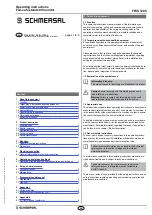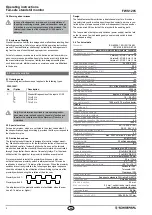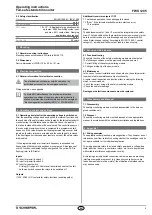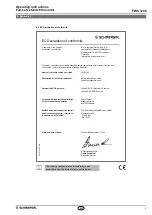
3
FWS 1205
Operating instructions
Fail-safe standstill monitor
EN
2.5 Safety classification
Standards:
EN ISO 13849-1; IEC 61508
PL:
up to d
Control category:
up to 3
PFH-value:
1.0 x 10
-7
/ h; Applicable for applications with
up to max. 50,000 switching cycles / year
and max. 80 % contact load. Diverging
applications upon request.
SIL:
up to 2
Service life:
20 years
3. Mounting
3.1 General mounting instructions
Mounting: snaps onto standard DIN rails to EN 60715.
3.2 Dimensions
Device dimensions (H/W/D): 100 x 22.5 x 121 mm
4. Electrical connection
4.1 General information for electrical connection
The electrical connection may only be carried out by
authorised personnel in a de-energised condition.
Wiring examples: see appendix
To avoid EMC disturbances, the physical ambient and
operational conditions at the place where the product is in-
stalled, must meet the provisions laid down in the paragraph
"Electromagnetic Compatibility (EMC)" of DIN EN 60204-1.
5. Operating principle and settings
5.1 Operating principle after the operating voltage is switched on
After the operating voltage has been applied, the internal functions and
the condition of the safety relays will be tested by the fail-safe standstill
monitor during the initialization phase. After this check, the inputs of
the fail-safe standstill monitor will be evaluated. The cyclic frequency of
the connected proximity switches is compared to a programmed limit
frequency. If the value drops below the programmed frequency at both
inputs, both safety relays are actuated and the enabling path is closed.
If the limit frequency is exceeded at least at one input, the safety relays
are disabled.
If the programmed upper or lower limit frequency is exceeded, the
frequencies of both proximity switches are compared. A divergence of
over 30% will be considered faulty and signalled. The yellow LED is
flashing (refer to ISD table).
Inputs
X1: input for proximity switch 1
X2: input for proximity switch 2
X3: input for reset switch
A rising (0/1) edge at X3 deletes all ascertained errors of the fail-
safe monitor and causes the relays to be switched off.
Outputs
(13/14, 23/24): NO contacts for safety functions (enabling paths)
Additional transistor outputs Y1/Y2
Y1: Authorized operation; the enabling path is closed
Y2: "Error"; if the fail-safe standstill monitor detects an error,
Y2 is switched.
Note
The additional outputs Y1 and Y2 must not be integrated in the safety
circuit. The feed cables of both proximity switches (power supply) must
be laid so that in case of a wire breakage only one proximity switch
is dead (star-shaped routing). According to EN ISO 13849-1, control
category 3, an individual fault must not lead to a loss of safety.
6. Set-up and maintenance
6.1 Functional testing
The safety function of the safety-monitoring module must be tested.
The following conditions must be previously checked and met:
1. Correct fitting of the safety-monitoring module.
2. Fitting and integrity of the power cable.
6.2 Maintenance
In the case of correct installation and adequate use, the safety-monitor-
ing module features maintenance-free functionality.
A regular visual inspection and functional test, including the following
steps, is recommended:
• Check the correct fixing of the safety monitoring module
• Check the cable for damage.
Damaged or defective components must be replaced.
7. Disassembly and disposal
7.1 Disassembly
The safety monitoring module must be disassembled in the de-ener-
gised condition only.
7.2 Disposal
The safety monitoring module must be disposed of in an appropriate
manner in accordance with the national prescriptions and legislations.
8. Appendix 1
8.1 Wiring examples
The application examples shown are suggestions. They however do not
release the user from carefully checking whether the switchgear and its
set-up are suitable for the individual application.
The wiring example refers to a closed safety guard and a voltage-free
state. Inductive loads (e.g. contactors, relays, etc.) are to be provided
with suitable interference suppression circuitry.
Avoid laying proximity switch connection cables in areas where strong
interference signals are present (e.g. frequency converters or cable
leads from powerful electric motors); the utilisation of shielded cables
may be necessary.
























